The Oregon Coast: Raw wind-blown beauty — and great chowder — warmed the heart of my Italian photographer
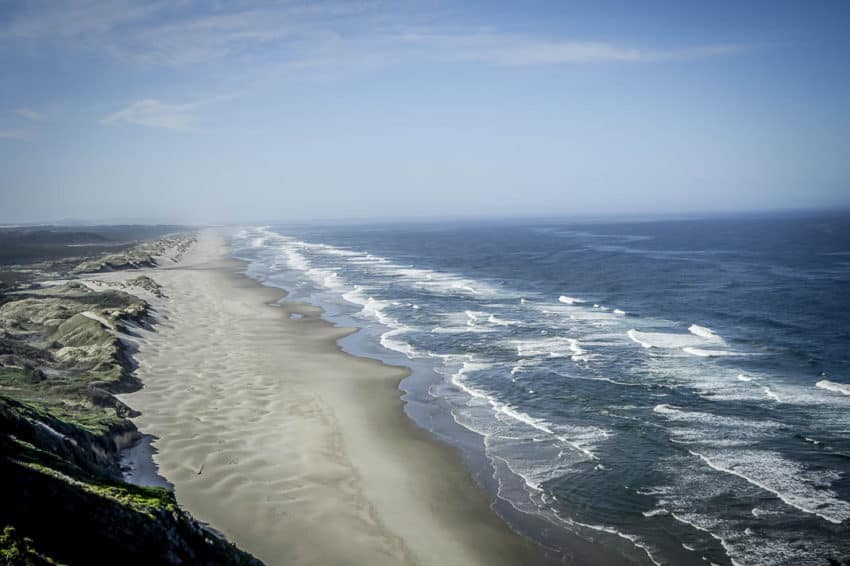
YACHATS, Ore. — I found it a little daunting last year when my Italian girlfriend said she wanted to see where I grew up. What kind of a ghoul tour could I give her in Eugene, Oregon? I could show her the bar parking lot where I passed out the night of my 21st birthday. Maybe she’d enjoy the street in front of my high school girlfriend’s house where I lost my virginity (the stick shift in the ‘67 Mustang could NOT have been designed for a more inconvenient spot). Maybe she’d like to see my frat house where they filmed “Animal House” while I was living there. Then again, she didn’t really understand the movie. Italians, God love ‘em, don’t find food fights remotely funny.
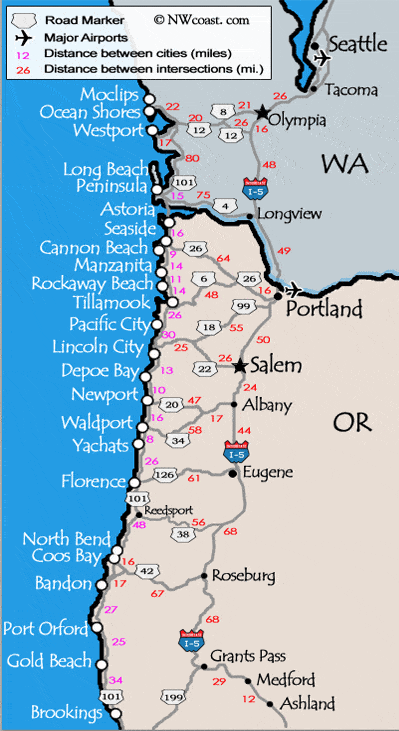
The most important thing on her must-see list, oddly, was Papa’s Pizza. It’s the pizza parlor where I worked the summer after high school graduation. She had a weird curiosity about her American boyfriend making pizzas. It didn’t matter that every single ingredient at Papa’s, from the tomatoes to the cheese to the salami, came from a box or can. Those pizzas had so few natural ingredients they were nearly synthetic. It was no concern that a Papa’s pizza could grease an International Harvester. She wanted to try it.
She also wanted to see my house, my school, my sisters. What she didn’t know much about was one of the best parts of my childhood, the part she wound up liking most during our recent two-week trip around the Pacific Northwest.
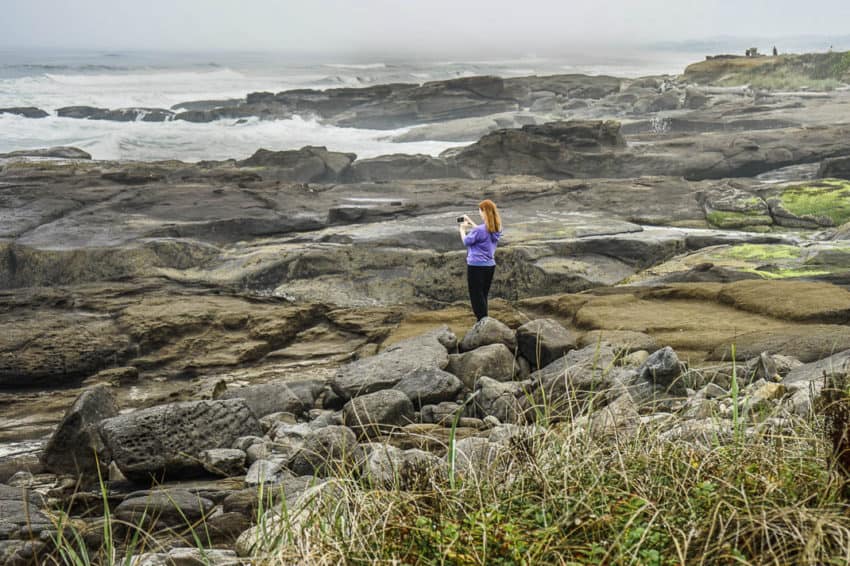
The Oregon Coast.
Notice it is not called the Oregon beach. The word “beach” conjures up images of bikinis and sunscreen, Frisbees and volleyball, swimming and palm trees. The Oregon Coast is cold. The ocean is freezing. It’s between 45-63 degrees (7-17 celcius), depending on the year. Don’t even think about swimming. I went in once when I was 10 years old and I swear I’ve been sterile ever since. Before we arrived, just in case we took a quick dip, I looked up the Italian word for “shrinkage.”
The weather itself makes it feel like it’s on the Bering Strait rather than the Pacific. It gets 60 inches (150 cm) of rain a year. Wind sweeps in like icy thunderbolts, reaching 60 mph in winter, and pierces your ubiquitous hoody regardless of season. It was August and I wore jeans and a long-sleeve shirt every day. Marina, being Italian, dressed as if she was mushing a dogsled over one of the poles.
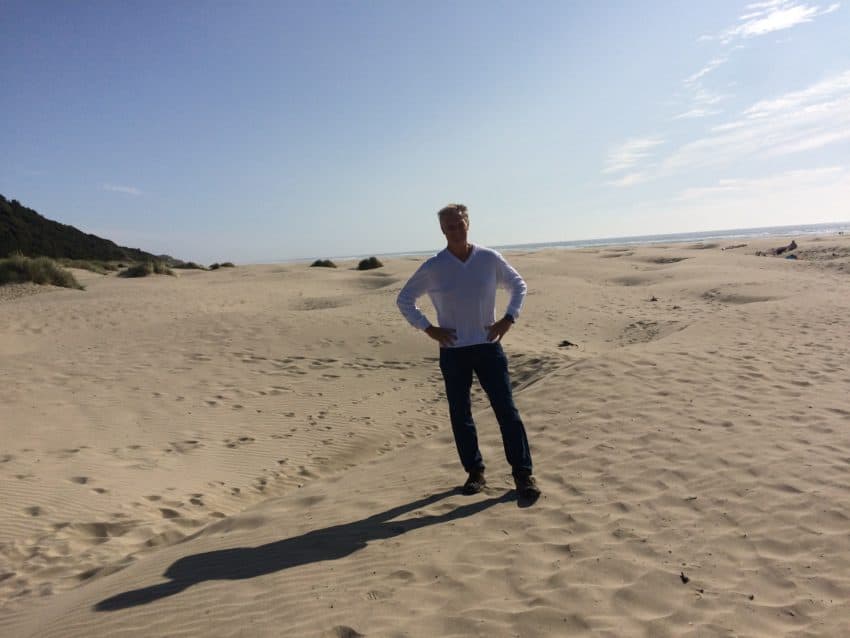
Yet we take pride in that as much as its raw beauty. It’s why we capitalize “Coast.” The Oregon Coast is so unique. No place has beaches as broad with such fine golden sand as Oregon. From Highway 101, which goes the length of the Coast, it looks like one long continuous sand dune. Yet we could practically pack the number of beachcombers we saw in our rental car. If the Coast was 20 degrees warmer the crowds would make Manhattan Beach look like a river bank in rural Kansas.
We Oregonians? We didn’t know any better. My family would take the hour drive from Eugene and have BBQs on the sand. Trying to find a sheltered spot where our fire didn’t get blown out after 30 seconds would’ve challenged Navy SEALs. My father and I played golf with one of his local friends, and I distinctly recall the wind sending one of my badly hooked drives halfway to the Marshall Islands. The next morning after a storm we’d walk the beach and see little sea creatures playing in tide pools. We’d find various sizes of glass balls that broke away from nets on Japanese fishing boats and floated to shore. I had a very learned uncle who flew out from Bethesda, Maryland, just to collect the perfectly black rocks he said could only be found on the Oregon Coast.
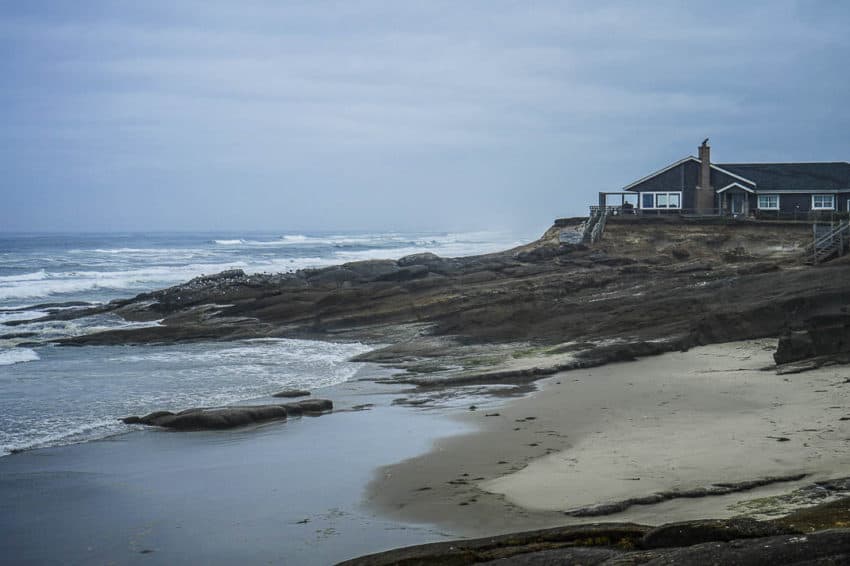
What also makes the Oregon Coast special is every grain of sand from the California to Washington borders is public land. In 1966, a motel owner in Cannon Beach, about 80 miles west of Portland, tried banning the beach behind his motel from all but his guests. Lawmakers quickly introduced the Beach Bill and since its signing on July 6, 1967, all of the Oregon Coast is public land.
The Oregon Coast doesn’t have any palm trees but it doesn’t have any Club Meds, either.

To reach the Coast we drove diagonally from Portland through McMinnville, near the heart of Pinot Noir country. If you didn’t know, Oregon has the best Pinot Noir in the world. Just ask Oregonians. Or look at the prices. You don’t get any home state discounts in my Oregon, buddy. We stopped at R. Stuart & Co., a downtown McMinnville wine bar where I paid $15 for a tasting of three fantastic single-vintage Pinots and one blend. Thirsty for more and possibly a present for us as we sat by the ocean later that day, I asked the cost for a bottle.
Fifty dollars for the single vintages; $60 for the blend. I looked outside to see if I was still in Oslo.
We continued down the road until we met the Coast at Lincoln City, not more than a small logging town when I grew up in the ‘60s but now rivaling Cannon Beach as one of the top tourist destinations on the Coast. We headed south and just short of Waldport I pulled into the Flying Dutchman Winery. It was in the mid-60s and windy.
Marina, shivering, wouldn’t get out of the car.
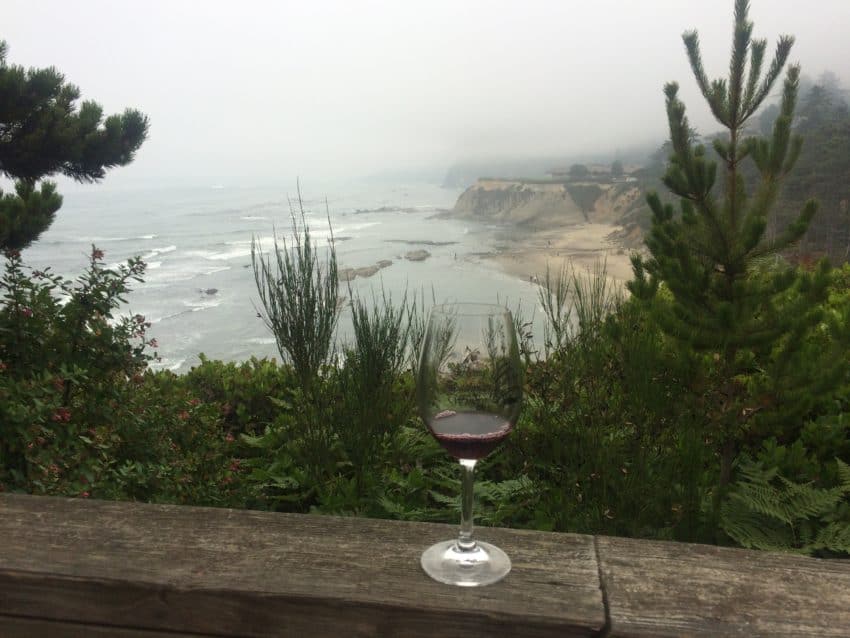
The cheerful man behind the bar poured me a lovely 2016 Pinot as well as a 2008 Cabernet Sauvignon and three others while we swapped notes on Italian versus Oregon wines. The wines were almost as good as the setting: right above the water with a big backyard featuring picnic tables all with fantastic views of the ocean. If you can handle the cold, it’s the perfect place to improve your wine palate.
I mentioned the view to Marina and suggested having a glass outside. She mumbled something in Romanaccio, the part of the Roman dialect exclusively reserved for profanity, that I fortunately didn’t understand.
However, she did join me for a bottle of local craft beer and some Oregon cheddar cheese behind our motel where a park bench pointed out to the ocean. While chilly, the Oregon Coast was one of the few places in the Pacific Northwest last month where raging forest fires hadn’t reduced the air to Beijing in July. We could smell the salt water as it pounded against the rocks. The gray overcast sky mirrored the ocean, a mix of roiling sea the color of steel and white sea foam.

Notice we stayed at a motel, with an “m,” not a hotel. For you Europeans, an American motel is like a hotel but usually just one or two stories and featured in most slasher movies. Not all have “FREE PORN” on their sign with a light missing. The Fireside Motel is a reputable, comfortable and very clean motel and an absolute steal at $120 a night.
In the summer the Oregon Coast is real expensive. As I searched for hotels I wondered if it would soon price itself out of the tourist market. I used Priceline, the U.S. bidding website where you put in a price, hotel level and date and if the computer finds a match, it automatically books you a room and charges your credit card. While you can’t review the hotel before the purchase, it offers major discounts at hotels desperately trying to fill empty rooms in the last week or so. I bid for four days and topped out at 175 euros. That’s nearly $200. Still no match.
What is this, the Oregon Coast or Saint-Tropez?
I punted. I took the recommendation from my sister who uses the Fireside for quick weekend getaways from Eugene with her husband.
It is pronounced YAH-hots, not “Yacchtssh” as Marina continually butchered. It comes from the Siletz Indian word for “Dark water at the foot of the mountain.” This little town of about 700 people has gone from an internment camp the U.S. Army used for local Indian tribes in the 19th century to No. 7 on travel guide guru Arthur Frommer’s top 10 list of favorite destinations in the … world. In 2007 Budget Travel listed it as one of the 10 Coolest Small Towns of the USA. That same year, the now-defunct VirtualTourist website called it one of the top 10 U.S. up-and-coming vacation destinations.
This all explains the lodging prices.
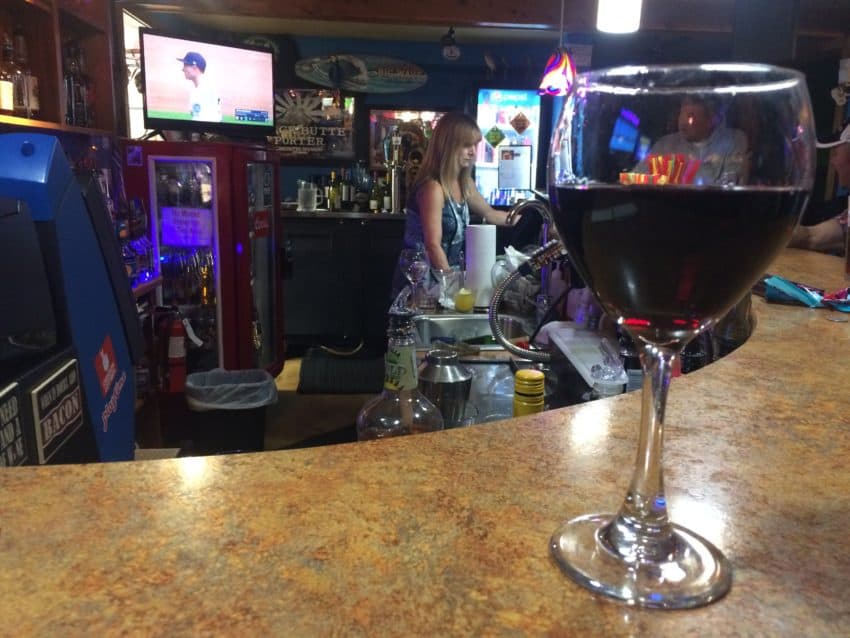
This also explains how Marina and I sat in Yachats Underground, the town’s local dive bar, talking to a 38-year-old mustachioed new father showing off his baby’s picture while bitching about local real estate. The Underground is Yachats’ nerve center. Hardened middle-aged women with bad hair and no makeup drink tall beers at the long, curved wood bar. A sign reading “DEEP SEA DRINKING” hung on the wall.
“You can’t find a place anymore in Yachats that isn’t taken by rich folks buying a second home,” the man said. “When you do find one, it’s $1,200 a month for a one-bedroom.”
Twelve hundred a month? That’s more than I pay for a one-bedroom in the middle of Rome.
“Nine years ago, $1,200 would rent you a house,” he said. “It’s $2,300 now.”
Yet falling on the cliche, you get what you pay for, after two days in Yachats I could see the appeal. Burned out? Divorced? Dying? Walk along the manicured trail that parallels the ocean. Holding hands, Marina and I meandered through tall grass for a couple hundred meters, climbed around driftwood and jumped over small tide pools. We found our way to a giant expanse of beach, void of anyone but a stray man, obviously burned out, divorced or dying, strolling the sand.
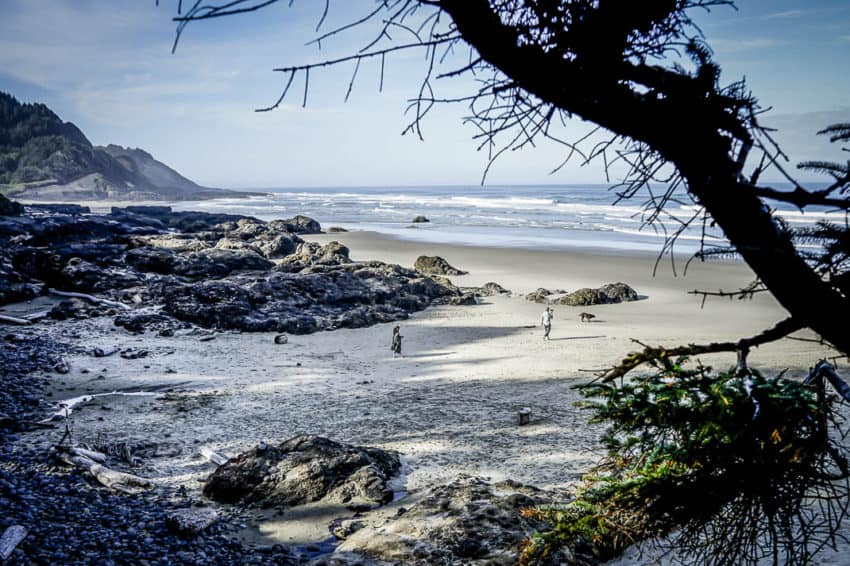
The late great Ken Kesey, a fellow University of Oregon grad who grew up in Eugene’s neighboring town, Springfield, based his “Sometimes a Great Notion” novel in 1964 on a struggling logging family on the Oregon Coast. The author of “One Flew Over the Cuckoo’s Nest” did a lot of writing in Yachats. As a writer, I always thought the Coast would be the perfect place to write.
Kesey said it’s too nice.
He once told an interviewer, “I can’t sit out there, look at the ocean and get any work done. It hammers the hell out of me.”
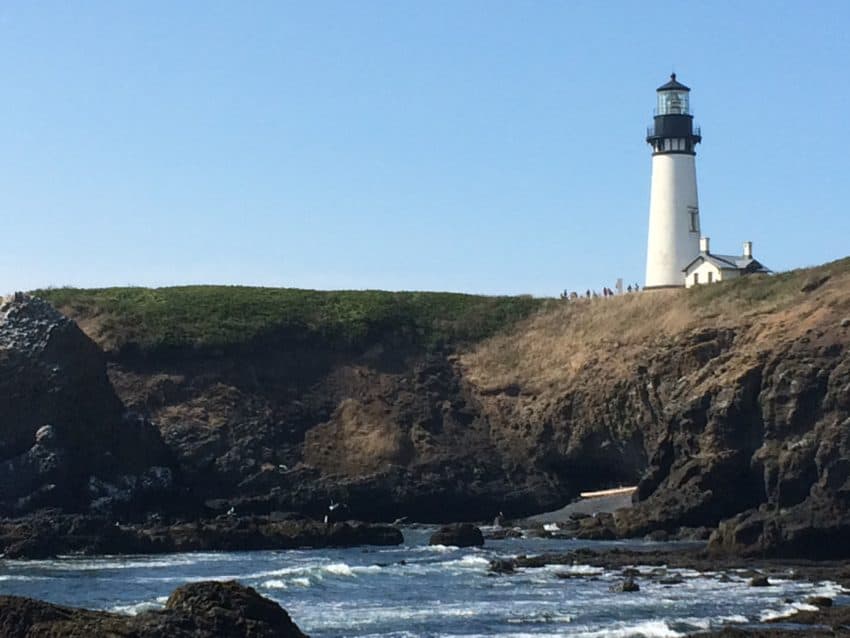
The Oregon Coast is a wilderness paradise. Just across Highway 101 from the ocean is the Siuslaw National Forest where 630,000 acres of trees provide canopy for a spiderweb of hiking trails. Add 30 degrees, humidity and deadly snakes and it would be the Amazon. I recall in years past hiking in the shade for an hour then coming across a crystal-blue lake I never knew existed.
Marina and I eschewed the hiking trails for Highway 101 and drove up the road 30 miles to Yaquinta Head Light. Lighthouses litter the Coast like sentries. The state has 11 and the 93-foot Yaquina is the tallest of them all. It can be seen from 20 miles out at sea. It’s just too bad it wasn’t built until 1871. Before its construction, 69 ships turned into kindling and underwater tombs from not knowing where the hell they were. Blimps and the U.S. Navy protected the lighthouse during World Wars I and II.
Yaquina Head Light sits at the end of promonotory that sticks out into the sea like a drunken sailor’s middle finger. The Oregon Coast has a lovely giant aquarium in nearby Newport. The beach at Yaquina is better. Marina and I descended a tall staircase to the beach where we walked along the sand and examined tide pools with starfish. The sun had appeared. Marina’s camera clicked like a horde of crickets.
Then something appeared in the water.
A black head. A little black head with whiskers. Then another. Sea lions, the kind you pay $29.50 to see in an aquarium, were surfacing just about 50 feet away from us. They stared at us. We stared at them. Just on impulse, I waved. I thought one of them nodded. Anyway, they dove and disappeared.
Then Marina pointed behind them. Rising out of the water was a long black, shiny object about 20 feet long. It was a whale, one of the 36-ton gray whales that cruise by here daily to feed. This is what I wanted Marina to see. This is what she can’t see in Italy.
This is the real Oregon. My Oregon.
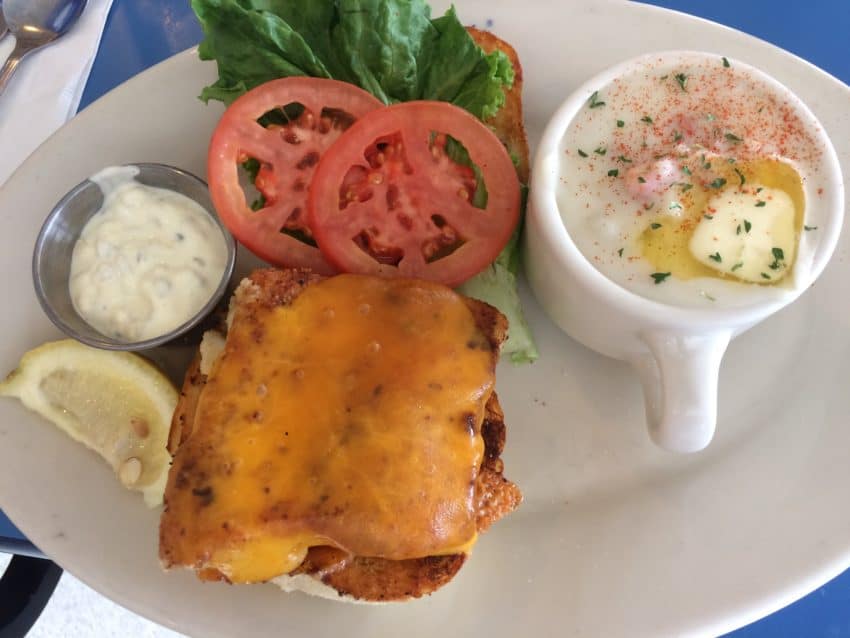
Besides the Oregon Coast’s beauty, I also spent the last year regaling Marina about its food. She fell in love with the clam chowder last year in Newport, Rhode Island. The clam chowder in the other Newport is better, I told her. Mo’s in Newport is as legendary as Oregon’s lighthouses. Paul Newman and Henry Fonda often ate here while filming “Sometimes a Great Notion” in 1970. Robert F. Kennedy campaigned at Mo’s in 1968, no doubt swearing off New England chawdah fahevah. In 2011 Coastal Living listed it among America’s Favorite Seafood Dives.
It started in 1946 by one Mohava Niemi, a local chain-smoking broadcaster who turned it into a hippy hangout in the ‘60s and ‘70s. She later bought an oyster farm and has expanded to six stores. Mo’s makes a half million pounds of chowder a year.
We ate across from the street from the original in a small annex consisting of about a dozen tables overlooking two fishing boats. Nautical flags hang on the wall as does a black and white photo of a 500-pound halibut. Waitstaff run around in T-shirts reading “Eat Like a Pirate. Drink Like a Fish.”
We ordered the Alaskan cod burger and chowder. The burger was excellent. The cod was grilled, not fried. But the chowder was orgasmic, packed with fat clams and soft potatoes and thick soup, all topped with a little pat of butter.
After I spewed glorious adjectives on Facebook, fellow Oregonians who claim Mo’s is overrated roasted me with rebuttals usually reserved for murder trials. They listed a half dozen other tiny dives that serve better chowder, meaning we’ll just have to come back again.
On our way to Eugene, Highway 101 South revealed phenomenal vistas of long, empty beaches without a person or — gasp! — lounge chair in sight. The state highway department was smart enough to include lookouts to pull in so Marina could snap away.

We stopped in Florence, just an hour west of Eugene and nearly surrounded by water. As we sipped our coffee outside a little gift shop, staring at the pleasure boats bobbing up and down on the peaceful Siuslaw River Marina had a familiar smile on her face. It’s a smile I see when we’re in special places in Italy, like staring at the Roman Forum at night or sitting alongside a canal in Venice or laying on a beach in Sicily.
“This is the most beautiful place I’ve ever been,” she said.
An endorsement on your home state’s beauty from an Italian, a better compliment can not be heard.


September 7, 2018 @ 9:46 am
Loved the whole story, especially Marina’s pictures. Glad she loved Oregon. We never tire of travelling that route in our rv. One of our favorite rv parks is just south of Florence right on Winchester bay. Sounds like you’ll return.
September 7, 2018 @ 9:54 am
Thanks, Kay. Yeah, we’re planning on returning to Eugene for Christmas next year. Then Marina can see what the Coast is like during a storm. Where’s your next adventure?
September 7, 2018 @ 6:14 pm
Greatness. That is what this story is.
September 8, 2018 @ 8:12 am
Thanks, Justin. Nice compliment. They say the best writing comes from the heart. Forty years removed, Oregon is still close to mine.
September 8, 2018 @ 8:37 am
John, Ciao from the gorgeous Val Gardena!
This is a lovely tribute to the Oregon Coast! That’s why we chose to live there after we left Italy. We sure enjoy the cool summers.
One correction: an adult gray whale weighs about 36 tons! At birth they are about 1200 pounds. When you and Marina come at Christmas, let me know and I’ll show you whales during migration. I am a Whale Watching volunteer between Christmas and New Years.
September 8, 2018 @ 9:39 am
Thanks, Laurel. And thanks for the correction. Where do you live on the Coast?
September 8, 2018 @ 10:01 am
Lincoln City. Pretty busy in summer, but the winters are very quiet.